Preston
Explore hidden histories, historic photos, and things you never knew about Preston from the collections and archives of Historic England.
Discover your local listed buildings and places
Introducing some of Preston's most historic sites, included in the National Heritage List for England. Some of these captions have been summarised by AI. Click through for the official List entry. Skip this section and go to place by numbers
Avenham Park
Preston
A public park designed by Edward Milner and laid out in 1861 incorporating an existing riverside walk which had been laid out 1847-9.
Plastic Classroom at Kennington Primary School
Fulwood
The Plastic Classroom at Kennington Primary School was the first fully-structural plastic building in Britain.
Preston Central Bus Station and Car Park
Preston
A bus station with multi-storey car park above, also incorporating a taxi rank (but excluding the pedestrian links).
The Black Horse
Preston
Hotel, now a public house, of 1898, by J A Seward of Preston for the Atlas Brewery Company of Manchester.
The Former Public Hall
Preston
The former Corn Exchange of 1822-24 remodelled as a meeting hall and entertainment complex known as the Public Hall in 1881-82, partly demolished in 1986, and now used as a public house.
Preston Cemetery
Preston
A cemetery laid out in 1855 retaining the original design and mature tree cover reflecting the C19 planting scheme.
Miller Park
Preston
A public park designed by Edward Milner in 1864 incorporating a riverside walk which had been laid out 1847-9.
Ye Horns Inn
Goosnargh
Public house, late C18, remodelled in the inter-war period. The attached and modified agricultural range and the rear extension are not included in the listing.
Cromwell's Mound Civil War fieldwork
Broughton
Cromwell's Mound, linked to the Battle of Preston in 1648, survives as a rare Civil War fieldwork monument.
Archbishop Temple School, including landscaped pools
Fulwood
Secondary school, 1964-1966, by Building Design Partnership. Brown brick with copper sheeting, mainly butterfly and monopitch roofs. Blocks of varying height.
Haslam Park
Ingol and Tanterton
Haslam Park, a municipal park opened in 1910 in Preston, was designed with significant contributions from landscape architect Thomas H Mawson, enhancing its layout and features.
The former Harris Orphanage
Fulwood
An early example of a charitable orphanage landscape laid out between 1884 and 1888 by Preston's Parks Superintendent, George Rowbotham, with a group of 'village homes' around a 'village...
115 and 115a Friargate (former Plough Inn)
Preston
Public house probably since the mid-C18, possibly with origins as a C17 house.
Front Portico and Towers of the Former St Augustines of C…
Preston
The front portico and flanking towers of the former St Augustine's of Canterbury Roman Catholic Church originally designed by the architect F. W.
Chingle Hall moated site
Whittingham
Chingle Hall is a medieval moated site with a 17th-century building, significant for its aristocratic status and potential preservation of original remains.
Preston War Memorial
Preston
A very substantial First World War civic memorial, 1926, architect Sir Giles Gilbert Scott, sculptor Henry Alfred Pegram.
Fernyhalgh War Memorial
Broughton
A First World War memorial of 1921 with additional names of the Second World War.
Preston Abstinence Memorial
Preston
A Gothic monument to the Preston Abstinence movement dated 1859, standing in Preston General Cemetery.
Explore more
Search for more listed placesPreston through time
This timeline shows the first period of use for buildings and places on the National Heritage List for England, just one of the details recorded for every list entry. Click around to see how Preston changes over time. Skip this section and go to aerial photos
Early medieval AD 410 to AD 1066
This period, often associated in England with Anglo-Saxons and Vikings, saw a reduction in urban living from the Roman period and increased migration from northern Europe.
Traces of this period can be found in cemeteries, particularly in artefacts and in some of the very early churches, as this period also saw the growth of Christianity in Britain.
Medieval AD 1066 to AD 1540
This period, sometimes known as the Middle Ages, began with the Norman invasion in AD 1066. It saw a significant rise in military and defensive buildings such as castles and earthworks, as well as religious houses dominating a largely agricultural landscape.
The monarchy and Church dominated the period, which also saw the break with the Roman Catholic Church and the English reformation.
Post medieval AD 1540 to AD 1901
The Post-Medieval period brought seismic changes to life in England, with religious reformation leading to the democratization of worship and the destruction of hundreds of religious houses.
In parallel, there was a huge expansion of scientific study and enlightenment that permanently altered the nation's social structure and landscape. Industrialization and mass production lead to wider global trade, emigration, and immigration.
20th century AD 1901 to AD 2000
The 20th century saw an incredible expansion of England's transport networks, with suburban growth shadowing rapid infrastructural expansion. The establishment of state schools, hospitals, and modern technical colleges, with new architectural styles, radically changed the appearance of towns and cities.
Two catastrophic world wars and the 1918 pandemic also brought unprecedented change, altering England's built environment and social structures forever.
Early medieval AD 410 to AD 1066
This period, often associated in England with Anglo-Saxons and Vikings, saw a reduction in urban living from the Roman period and increased migration from northern Europe.
Traces of this period can be found in cemeteries, particularly in artefacts and in some of the very early churches, as this period also saw the growth of Christianity in Britain.
Medieval AD 1066 to AD 1540
This period, sometimes known as the Middle Ages, began with the Norman invasion in AD 1066. It saw a significant rise in military and defensive buildings such as castles and earthworks, as well as religious houses dominating a largely agricultural landscape.
The monarchy and Church dominated the period, which also saw the break with the Roman Catholic Church and the English reformation.
Post medieval AD 1540 to AD 1901
The Post-Medieval period brought seismic changes to life in England, with religious reformation leading to the democratization of worship and the destruction of hundreds of religious houses.
In parallel, there was a huge expansion of scientific study and enlightenment that permanently altered the nation's social structure and landscape. Industrialization and mass production lead to wider global trade, emigration, and immigration.
20th century AD 1901 to AD 2000
The 20th century saw an incredible expansion of England's transport networks, with suburban growth shadowing rapid infrastructural expansion. The establishment of state schools, hospitals, and modern technical colleges, with new architectural styles, radically changed the appearance of towns and cities.
Two catastrophic world wars and the 1918 pandemic also brought unprecedented change, altering England's built environment and social structures forever.
Aerial photos of Preston
Aerial photography helps reveal secrets of England's changing landscapes that are impossible to see from the ground. Skip this section and go to archive images
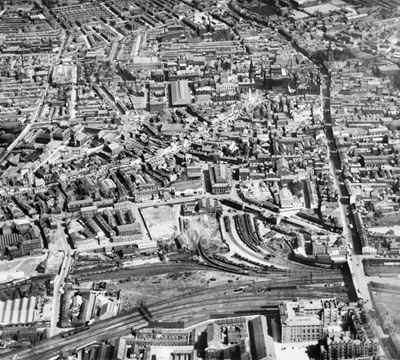
Preston
The city centre, Preston, 1937
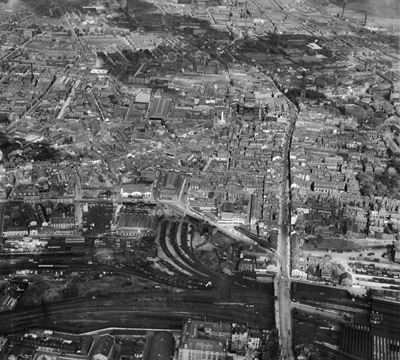
Preston
The city centre, Preston, 1949
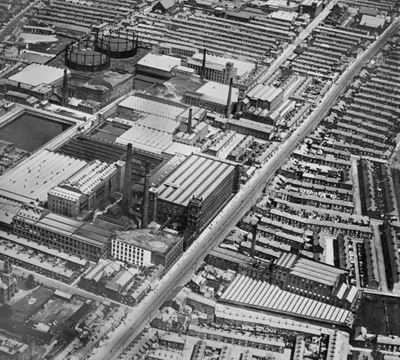
Preston
Cotton Mills between Ribbleton Lane and New Hall Lane, Preston, 1925

Preston
Hartford Mills, Preston, 1950

Preston
The town centre, Preston, 1920

Preston
The city centre, Preston, 1949
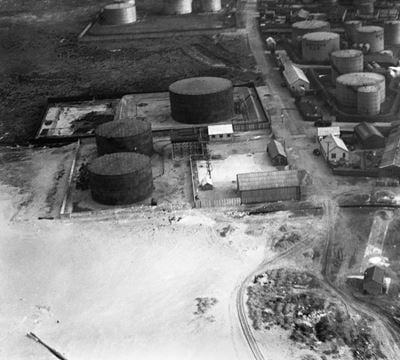
Preston
Watsons ROP oil storage depot at the entrance to Preston Docks, Preston, 1931

Preston
Shell-Mex and BP Ltd oil storage depot on Chain Caul Road, Preston, 1953

Preston
Preston Prison, Yard Works and housing around Larkhill Street, Preston, 1920
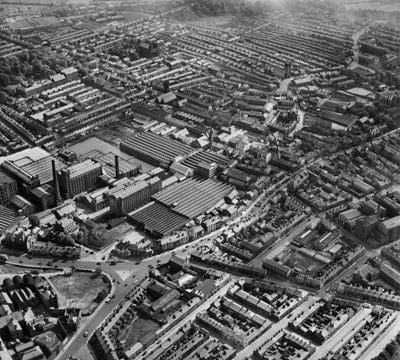
Preston
Horrockses, Crewdson and Co Ltd Yard Works (Cotton) and environs, Preston, 1949
Preston in the Historic England Archive
The Historic England Archive cares for over 15 million images, dating from the 1850s to the present day. Discover stunning images of Preston's past. Skip this section and go to stories about heritage
Charles George Harper Collection
Preston, Lancashire
Date created: 1892 - 1933
The entrance doorway to Dun Cow Rib Farmhouse
Eric de Mare
Preston, Lancashire
Date created: 1945 - 1980
Exterior perspective view of the Victoria Warehouses in Preston Docks.
John Gay Collection: Modern Architects
Ingol, Preston, Preston, Lancashire
Date created: 1978
The newly constructed Employment Rehabilitation Centre in Ingol, Preston
John Laing Collection
Preston, Lancashire
Date created: 23 Oct 1969
A group of suited men, including Lord Stokes (second from left), gathered outside Preston Bus Station on the day of the opening ceremony
London, Midland and Scottish Railway Company
Preston, Lancashire
Date created: 1883 - 1900
Park Hotel viewed from Miller Park
Nigel Temple Collection of Postcards of Parks and Gardens
Miller Park, Preston, Preston, Lancashire
Date created: 1900 - 1905
GENERAL VIEW FROM GARDENS WITH FOUNTAIN IN FOREGROUND
Charles George Harper Collection
Preston, North Tyneside
Date created: 1847
Watercolour painting of the Monk's Stone in its original location outside Monk House Farm
John Gay Collection: Modern Architects
Ingol, Preston, Preston, Lancashire
Date created: 1978
Inside the kitchen at the newly constructed Employment Rehabilitation Centre in Ingol, Preston
John Laing Collection
Preston, Lancashire
Date created: 26 Jun 1969
View of Preston Bus Station under construction
London, Midland and Scottish Railway Company
Preston, Lancashire
Date created: 17 Nov 1927
Two vans parked outside the Cantrell and Cochrane depot at Preston West Lancashire Station
Nigel Temple Collection of Postcards of Parks and Gardens
Miller Park, Preston, Preston, Lancashire
Date created: 1900 - 1920
GENERAL VIEW LOOKING ALONG PATHWAY TOWARDS IVY BRIDGE
Nigel Temple Collection of Postcards of Parks and Gardens
Miller Park, Preston, Preston, Lancashire
Date created: 1900 - 1930
GENERAL VIEW LOOKING UP TERRACE STEPS
Stories about heritage in your local area
Historic England publishes news, blogs, research, videos, and podcasts celebrating England's rich heritage. Discover the stories we have about Preston. Skip this section and go to education
A Brief History of Reinforced Concrete Buildings
Mentions Preston Central Bus Station and Car Park
Reinforcing concrete made highly complex large-scale structures possible.
England's Suburbs 1820-2020
Mentions Preston
Historic England’s major national research project on the heritage of suburbs reaches its conclusion.
Kirkham: Forging a Heritage Programme as a Bridge to Wellbeing
Mentions Preston
Supporting wellbeing and cohesion in a Lancashire community through a social prescribing programme based on interacting with heritage.
Investigating the Built Environment in Lancashire’s Historic Textile Areas
Mentions Preston
Exploring the local infrastructure that underpinned the industrial revolution.
Picturing Construction, Constructing Identity
Mentions Preston
Construction history researcher Tony Presland gives us a preview of his developing research into the John Laing Collection of photographs.
Heritage at Risk in the North West Revealed
Mentions Church of St Ignatius, Preston
3 sites have been saved and 6 sites added to the Heritage at Risk Register 2023 in the North West of England.
Enriching the List, Enriching Lives
Mentions Preston
Research into how Historic England's Enriching the List initiative can help the personal wellbeing of contributors.
11 Remarkable Historic Pubs Given Protection
Mentions The Black Horse, Preston
A project to save rare historic pub interiors sees 11 remarkable pubs being newly listed, having their listing upgraded or list entry updated.
£15.5 Million Christmas Boost for 140 Heritage Organisations
Mentions Preston
The Culture Recovery Fund: Round Three will support organisations as they make plans for financial sustainability in 2022
Heritage and Craft Workers Across England Given a Helping Hand
Mentions Preston
142 historic sites across England are receiving grants worth £35 million through the government’s Culture Recovery Fund.
Public Call-out Uncovers England’s Secret and Unknown Memorials
Mentions Preston Abstinence Memorial, Preston
Hundreds of nominations received as public share their knowledge of local monuments, street shrines and community tributes.
12 of the Best Post-War Schools Listed
Mentions Plastic Classroom at Kennington Primary School, Archbishop Temple School,, Preston
Newly listed school buildings include a plastic classroom known as 'the bubble' in Preston and a 'high-tech' infants school in Hampshire.
Battle of the Somme Memorials Listed
Mentions Preston War Memorial, Preston
We mark 100 years since one of the bloodiest battles in the First World War with 15 war memorial listings
Preston's social history through photos
Over 10,000 images from the Historic England Archive have been specially selected and re-captioned for teachers, students, and anyone who wants to learn more about their local area. Skip this section and go to grant-aided places
The 'Cretemanor', Albert Dock, Preston, Lancashire
Period: World War One (1914 - 1919)
Due to a shortage of steel during the first world war, several experiments were made in the construction of ships made from iron and concrete.
The 'Cretemanor', Albert Dock, Preston, Lancashire
Stephen Simpson's Gold Thread Works, Avenham Road, Preston, Lancashire
Period: Victorian (1837 - 1901)
These gold thread making buildings date mostly from the 1860s.
Stephen Simpson's Gold Thread Works, Avenham Road, Preston, Lancashire
Statue of Sir Robert Peel, Winckley Square, Preston, Lancashire
Period: Victorian (1837 - 1901)
This statue of Sir Robert Peel was put up in 1852. He was born in Lancashire. He was twice Prime Minister and also helped to create the police force.
Statue of Sir Robert Peel, Winckley Square, Preston, Lancashire
Tags
St Joseph's Orphanage, Theatre Street, Preston, Lancashire
Period: Victorian (1837 - 1901)
St Joseph's Orphanage was built in 1872 by R.W.Hughes for the patron Mrs Maria Holland. She gave a capital fund of nearly £20,000 to found St.
St Joseph's Orphanage, Theatre Street, Preston, Lancashire
School at former Harris Orphanage, Garstang Road, Broughton, Lancashire
Period: Victorian (1837 - 1901)
These buildings are part of the Harris Orphanage. It was a 'village homes' type orphanage built in 1884-88 to house 120 children.
School at former Harris Orphanage, Garstang Road, Broughton, Lancashire
Preston Royal Infirmary, Deepdale Road, Preston, Lancashire
Period: Georgian (1714 - 1836)
This building was originally called Royal Brook House. It was built in 1829-33. It was built by the Poor Law Vestry as a House of Recovery.
Preston Royal Infirmary, Deepdale Road, Preston, Lancashire
Preston Employment Rehabilitation Centre, Ingol, Preston, Lancashire
Period: 1970s (1970 - 1979)
Inside a newly furbished single bedroom at the Employment Rehabilitation Centre in Ingol, Preston
Preston Employment Rehabilitation Centre, Ingol, Preston, Lancashire
Preston Employment Rehabilitation Centre, Ingol, Preston, Lancashire
Period: 1970s (1970 - 1979)
Inside one of the industrial workshops at the newly constructed Employment Rehabilitation Centre in Ingol
Preston Employment Rehabilitation Centre, Ingol, Preston, Lancashire
Discover more
Ready for more local stories? Take a look at these other places nearby

